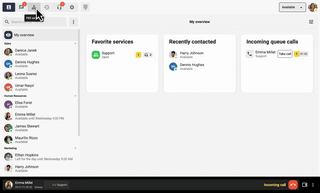The further we get into 2024, the more changes we see in customer experience (CX). We are at a tipping point where digitalization and AI are changing the way we look at the relationship between businesses and consumers. Here we highlight five emerging trends that are shaping the future of customer experience.
1. Even more personalized customer experiences
In 2024, the personalized customer experience has gone from a nice-to-have to a must-have among consumers. Today’s standard is highly individualized and tailored experiences. In the age of algorithms, businesses cannot afford to be left behind. For example, in Hubspot, users can dynamically add personalized fields depending on the information they have about the customer.
Smart tools to analyze data and the use of predictive algorithms allow companies to see customers’ preferences and possibly anticipate their future wishes. As well as driving sales, it can also build loyalty and customer satisfaction.
2. use of AI in the customer experience
Much has been said about artificial intelligence (AI), but regardless, it’s here to stay – and so is the customer experience. Companies are implementing AI to, among other things, analyze large amounts of customer information and provide relevant offers. This also includes chatbots and automated responses, as well as analyzing customer interactions as transcripts.
To find out more about how AI is changing customer service, check out this podcast:
But with these benefits come challenges related to data management and security. Companies are currently struggling to balance the use of AI for better customer experiences with protecting consumer privacy, so that AI becomes an added value and not an intrusion.
3. More virtual assistants and chatbots
Today’s customers are used to using live chat to get answers to their support questions. Virtual assistants and chatbots are now a common feature on many company websites and apps. In addition to answering the most common questions, they can also offer personalized recommendations and solutions tailored to each user’s needs. Thanks to machine learning and NLP (natural language processing), they can provide an often human and empathetic response.
Perhaps the main advantage is that it works around the clock (as long as the service is turned on). This means that you are less dependent on a support team to answer basic questions around the clock. At the same time, it should not be seen as a substitute for actual support agents. These tools can relieve some of the burden, but your agents are there to provide personalized and professional support for more complex issues. This combination allows consumers to receive both fast and personalized responses, leading to higher trust and customer loyalty.

4. The importance of soft skills in the digital era
While the digital era has changed customer service in many ways, soft skills such as empathy and effective communication remain crucial to the customer experience. Companies recognize this and are actively training their customer service teams to improve these skills.
At the same time, they use smart tools to analyze and improve these interactions. Tools like voice analytics and AI provide valuable feedback on how agents are performing, helping them to refine their approach and offer a better, more personalized experience.
5. Omnichannel and a seamless experience
What makes a successful customer experience? The key is to provide a consistent experience, preferably across multiple channels. Nothing is more frustrating than being shuttled between support agents and departments and having to repeat your case every time. A seamless experience is crucial.
CRM systems and customer data platforms allow companies to gather information from different channels. You may already use a CRM system like Hubspot or Salesforce. An omnichannel solution that brings together your touchpoints allows you to get an overview and see what can be improved in your customer contact.
Executive summary
Our perception of what makes a great customer experience changes every year, and 2024 is no exception. Companies that take the next step are those that embrace new trends and technologies, such as artificial intelligence, personalization and omnichannel. This way, you are ahead of the game and always have the customer experience in mind. At the same time, it’s important not to rely solely on smart tools, but to make sure they are embedded in your ways of working and used to make your employees more efficient. Doing so will go a long way, and your customers will thank you.

